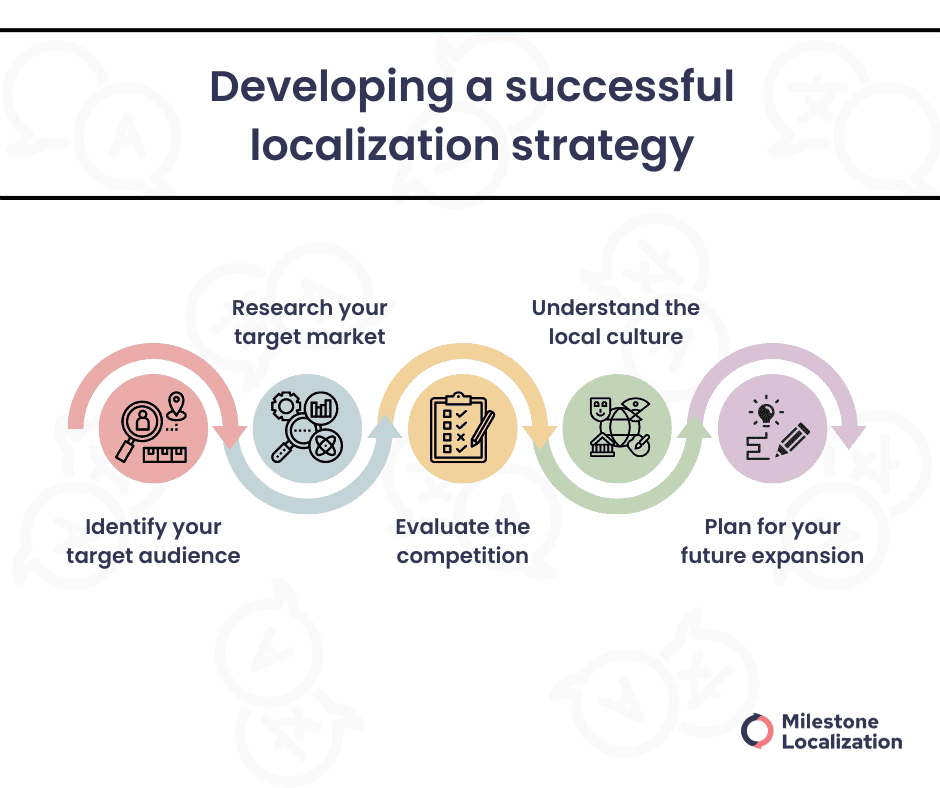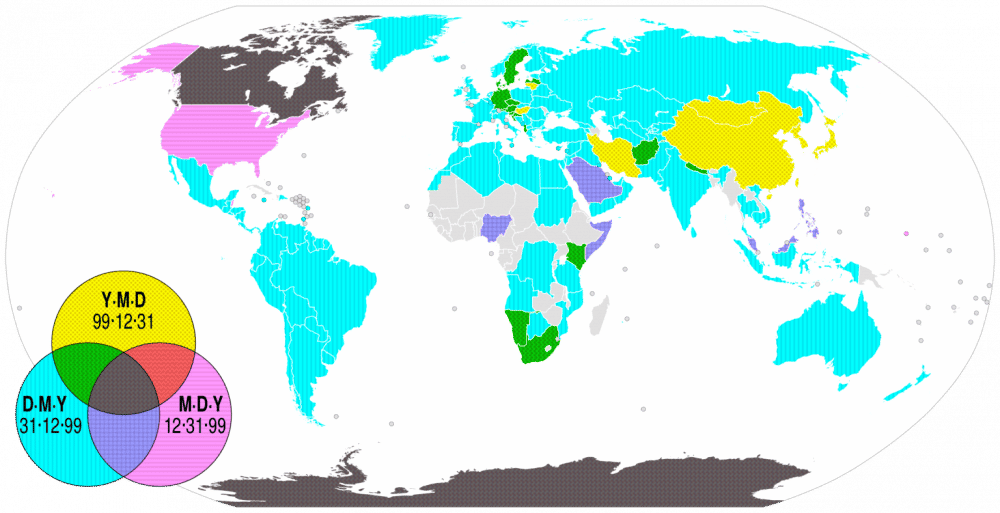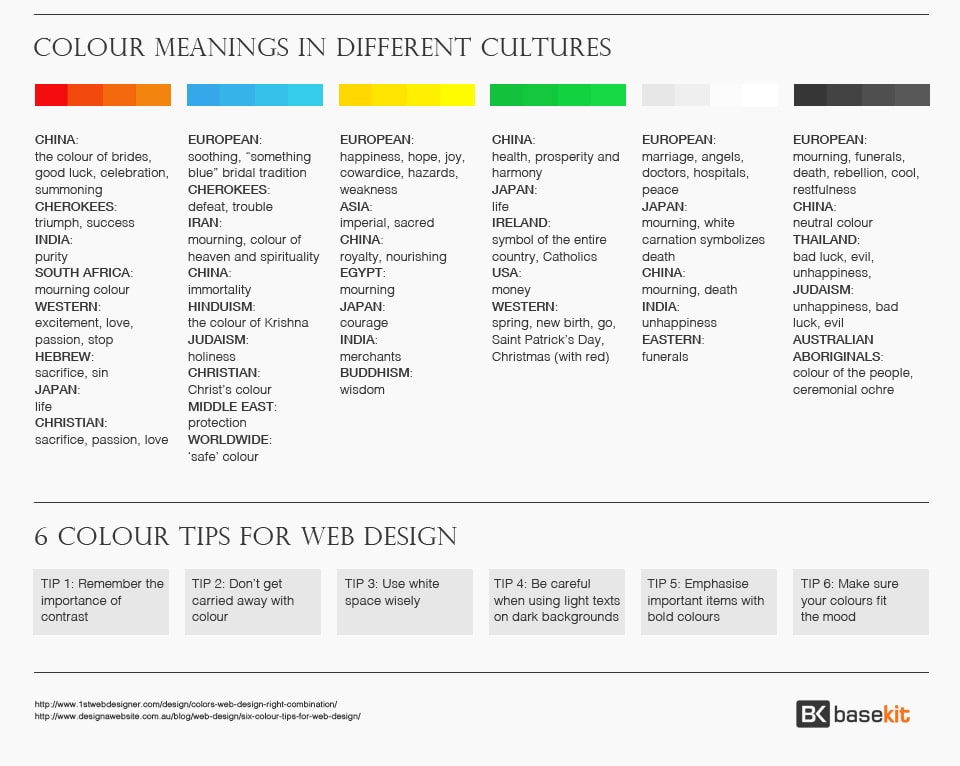Localization has become a critical tool when trying to succeed in new international markets.
75% of all internet users seek information on search engines in their native language. Furthermore, 60% of internet users favor making purchases from websites that provide content in their native tongue.
Localization is a complex process of adapting your product, app, or website to the cultural and linguistic preferences of your target group. In other words, localization can help you reach new customers by offering your products and services in such a way that they fit the tastes of your target audience.
To get good results out of localization, you need a good localization strategy.
In other words, simply translating your content won’t be enough to please your potential international customers. You should localize everything, from using local phone numbers to using the appropriate symbols and icons.
In the following blog, we will share some tips on how to create a good global localization strategy as well as the most important aspects of your business that you need to localize.
What is a localization strategy? How to develop a localization strategy?
“Localization strategy” is a plan for translating and adapting your content. It includes identifying which languages you want to translate into, which elements you want to be localized, etc.
A good localization strategy takes into account the needs and preferences of the target audience while still keeping an eye out for any competitors and technical and legal requirements in the countries they want to expand to.
Localization does not aim to create an entirely new product but rather to make it accessible to new customers. To do so, it takes into consideration the local language, but most importantly, the local culture.
Incorporating multilingual customer support is a critical extension of a successful localization strategy, ensuring that businesses not only speak the language of their customers but also effectively address their needs and inquiries in a culturally sensitive manner.
There are a few factors you need to consider to develop a successful global localization strategy. Otherwise, you risk disappointing or even offending your customers.
Identify your target audience
Most importantly, you need to identify your target audience. Localization always keeps the customer in mind, so you need to spell that out at the very beginning.
Successful localization requires a clear perspective on who your customers are, what they want, and how they can benefit from your product or service.
A good way to identify your target audience is by looking at where your international customers are coming from. In this way, you can limit yourself to a few countries, and then you can move on to the next step.
Research your target market
After you have picked some countries, you need to research these markets in depth. For instance, you can look for statistics or current trends that can have a favorable effect on your sales.
Additionally, market research will assist you in identifying new methods of customer contact. Social media platforms, for instance, are the best way to do this in several nations. However, advertisements on television and in print are still prevalent.
You need to do your research to understand how to devise your strategy. This is why you should take time and make sure that you have a good understanding of the dynamics of your target market.
Also read: Doing Business In China: Cultural Differences You Need To Know
Evaluate the competition
While doing your research on the target market that you have chosen, you need to look out for any products or services that might be similar to yours.
You can take appropriate action and look for ways to edge out the competition if you can spot competitors early on (localization is, indeed, one of them).
For instance, you can look for ways to improve your current products so that you can attract more customers when you launch your business in the new locale.
Understand the local culture
Once you have picked a locale, you can dive into its culture and try to gain a better understanding of how the local customs and traditions work. In this way, you can avoid any misunderstandings.
Using symbols that are insulting in a particular culture, for instance, might damage the reputation of your brand. You can ensure that you stay away from them once you realize that.
Also read: Business In The Middle East: Cultural Differences You Need To Know
Plan for your future expansion
Creating a localization strategy does not have a finish line. Rather, it is a process, and thus, it never ends.
You need to constantly think about the future and how to optimize your strategy for growth. To do so, you need to continually monitor your progress and make changes whenever needed.
What elements besides translation do you need to consider for your localization strategy?
Local phone numbers
Phone numbers are often overlooked when developing a localization strategy. When localizing for different countries, it is vital to provide in-country phone numbers to make it easy for customers to contact your business.
For example, phone numbers start with the country code +1 for the United States and +91 for India.
If you intend to further localize for different regions, you must provide local phone numbers.
They have unique area codes and formats, so residents can quickly identify them.
For example, (561) for a South Florida local number or (22) for a Mumbai local number.
You can buy phone numbers in bulk to reduce costs while localizing them for different locations. Even if you are not operating your business in these locations physically, you can always forward incoming calls from your local phone numbers to your main number. This way, you can establish a local presence in your target market and benefit from it.
Having a local phone number can help with customer service and sales activities, as well as the marketing of your company.
Also read: Localization vs Globalization vs Internationalization vs Translation
Currency, date, and time formats
Currency, as well as time and date formats, are some of the crucial technical elements of localization. These seemingly unimportant details show your customers that you value them and want to make their experience more enjoyable.
Hence, you need to make sure that everything is localized for your target market.
For instance, in the US, the most common date format is MM/DD/YYYY while in Europe it is DD/MM/YYYY.
You need to take into consideration other differences, such as time format. In the US, the 12-hour clock is most widely used, while in Europe – a 24-hour notation is.
Currencies usually vary across countries, so you need to look into more detail for each specific market. What’s more, in some countries, there might be more than one official currency.
Local payment methods
Customers in different locales often have different payment preferences. For example, people in Switzerland prefer to pay in cash, while in countries like Sweden, people always use card payments.
Only 23% of all purchases are paid with an international credit card (such as Visa, Mastercard, or Amex). At the same time, more than 70% of payments are made via bank transfers, digital wallets, or cash-based payments.
Therefore, before you launch your product into a new market, you need to do some research on the payment preferences of your potential customers. Offering a wide range of payment options tailored to the specific market would help you increase your reach.
Also read: Localization and Translation Costs: Breakdown Of Factors Involved
Go Global With Localization
Milestone helps you seamlessly translate content & localize your website, products, services, and more in 70+ languages. Get in touch with us for a special discount.
Visual materials
Images and any other visual materials are highly culturally influenced elements, and as such, they should be localized for each specific market.
Since pictures often rely on culturally specific symbols or beliefs, they might not be as meaningful in every locale they are put in.
For example, a picture of a Christmas tree would be odd and even meaningless to your customers who do not celebrate Christmas. However, a black background image is a more universal visual element and provide a consistent & professional look for your brand, regardless of where your customers are located.
Colors
Colors are an important aspect of the design of every product or service. Choosing the wrong colors, however, can be devastating.
Colors, similarly to images, are loaded with cultural meanings that don’t necessarily translate well into other cultures.
The simplest example would be the color white, which is associated with purity and hope in Western cultures while, in Eastern ones, it is a symbol of death and mourning.
Also read: Localizing Colours For Different Cultures
Symbols and icons
Symbols and icons are very similar to colors and images. They have very culturally specific meanings, and thus, one should always make sure that they are adapted for the particular target market.
For example, the sign for “okay,” which most people use in the Western world, has a vulgar meaning in Arab-speaking.
Another example is the slightly smiling emoji, which in China, surprisingly, is a sign of disbelief.
Text length and direction
Text expansion is very common in translation and localization. For example, texts translated from English into German are usually much longer and, thus, take up more space.
If you haven’t considered this when initially designing your product or app, you might be facing some serious issues with your UI.
Text direction might also cause you some issues. Languages such as Arabic and Hebrew, which are right-to-left languages, might not be supported by some of the fonts or tools that you use for your app or website. Therefore, it is always advisable to check beforehand.
Localizing customer support
When entering a new market, you need to make sure that you can offer customer service in the local language.
Also read: How to Localize Your App and Reach New Users
In some circumstances, this necessitates the establishment of a brand-new contact center in the desired location. Hiring bilingual agents at home or agents from remote teams is an additional option.
What’s more, you need to provide local phone numbers. In this way, your customers will be able to call without having to worry about any additional taxes for international calls.
Last but not least, you need to adapt your working hours to the time zone of your customers and their location.
Indeed, customer support is crucial if you want to provide a high level of customer service to all of your customers, regardless of their locations.
Social media accounts
Social media has become one of the main channels for reaching new customers.
Social media has developed into a tremendous tool for connecting with both present and future clients. Therefore, it’s crucial to produce material that is tailored to each of your target regions’ cultures.
In this way, you can highlight and share your brand’s mission and story. What’s more, the content needs to resonate with your audience on both cultural and emotional levels. Localization, in turn, can help you achieve that through strategic planning and execution.
Also read: Top 10 Tips For Social Media Localization
Consider local legal regulations
Legal requirements are another aspect that you need to consider before finalizing your localization strategy.
Different countries have different laws and regulations concerning privacy policies, cookies, and terms and conditions.
For example, in the European Union, according to the General Data Protection Regulation (GDPR), companies need to get explicit consent from website visitors before collecting or sharing their data.
In other words, if you want to expand into a country that is a member of the European Union, you need to consider this and make sure that you comply with the requirements of the GDPR.
App submission requirements
If you want to localize your app and make it available in new app stores, make sure to have a look at the policies and requirements for each app store.
For instance, iOS apps are required to support both Simplified and Traditional Chinese according to the App Store Review Guidelines.
Also read: 6 Reasons Why Mobile App Localization Matters For Global Success
In conclusion
Personalization is crucial if you want to be ahead of your competition. Localization in this regard is the best way to adapt your product and services to the cultural beliefs and preferences of your target audience.
This process of adaptation, however, is not linear, and you need to constantly monitor your performance and make changes accordingly.
Only in this way, can you ensure that your business will gain international recognition in various foreign markets. Indeed, happy and satisfied customers are the best way to achieve success in the global market, so you should concentrate all your efforts on achieving that.
Go Global With Localization
Milestone helps you seamlessly translate content & localize your website, products, services, and more in 70+ languages. Get in touch with us for a special discount.
















